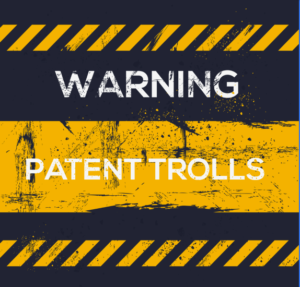The (Patent) Troll Toll: NC’s Abusive Patent Assertions Act
While we often write about section 75-1.1 of North Carolina’s General Statutes on this blog, today’s post examines another statute contained in Chapter 75: the Abusive Patent Assertions Act. First, we’ll take a brief look at the Act. Next, we’ll examine the first (and based on our research, the only) judicial decision discussing the Act. Finally, we’ll offer some thoughts on how the Act interacts with section 75-1.1.
The Road to the Toll Booth
The APAA takes aim at non-practicing entities (NPEs), also known as patent trolls. NPEs typically do not seek to commercialize patents by developing products or technologies. Often, they operate only to license and sue over patents. NPEs send “license-or-litigate” letters to alleged patent infringers, offering to license the patent for a much lower price than the high cost of patent litigation. Many NPEs engage in these practices with little regard to validity of the patents or the merits of the infringement claim. These tactics lead to so-called in terrorem settlements. Parties pay licensing fees to avoid litigation costs.
If, for example, a small business developed “Kitten Mittens,” an NPE holding a dubious patent for mittens (prior art, much?) could allege infringement and offer a licensing fee to avoid litigation. Kitten Mittens would then face a Hobson’s choice: pay the licensing fee or incur even more substantial expense defending a potentially baseless patent-infringement lawsuit.
The APAA targets these types of patent-troll practices by prohibiting bad-faith assertions of patent infringement. What is a bad-faith assertion? The Act doesn’t define this, but it gives several non-exhaustive factors for courts to consider in making that judgment.
The APAA has potent remedies:
- Damages
- Costs and attorneys’ fees.
- The greater of (1) $50,000 or (2) three times the amount of damages, costs, and attorneys’ fees.
- Requiring a defending party to post a bond of up to $500,000 for a good-faith estimate of the damages, costs, and attorneys’ fees that the claimant is likely to recover.
The North Carolina Attorney General can conduct investigations and file suits under the APAA. The Attorney General or others targeted by an NPE’s bad-faith infringement assertions may also join lawsuits alleging violations of the Act. This increases the likelihood of a claim going the distance, as an NPE would have to settle with more parties to end the case.
The APAA contains one key limitation: only NPEs can be sued under it. The APAA defines NPEs as entities that for the prior two years—and setting aside selling and licensing patents—did not engage in (1) work to create, test, qualify, modify, or validate technologies or processes to commercialize goods or services, (2) manufacturing, or (3) providing goods or commercial services. So the APAA doesn’t reach just anyone who makes a bad-faith patent-infringement assertion; only patent trolls.
Judicial Speedbumps
Last fall, Chief Judge Thomas Schroeder of the Middle District of North Carolina issued a decision examining the APAA. In that case, a company called NAPCO, Inc. sued an alleged patent troll, Landmark Technology A, LLC, under the Act and for declaratory judgments of patent invalidity and non-infringement. Landmark allegedly sent identical demand letters to various companies alleging patent infringement and offering a $65,000 licensing fee to avoid litigation. The letters allegedly did not identify the patentholder, nor did they describe how the target company was infringing the patents.
Landmark responded to the claim by unleashing a barrage of constitutional challenges to the APAA, including that it was preempted and violated the First Amendment, the Equal Protection Clause, and the Dormant Commerce Clause. This spurred amicus briefs from the North Carolina Solicitor General and several technology companies and trade groups, both urging Chief Judge Schroeder to uphold the APAA’s constitutionality.
Ultimately, Chief Judge Schroeder rejected each of Landmark’s constitutional challenges. But in doing so, he grafted some judicial requirements on to claims under the APAA.
To avoid preemption under federal patent law, a clear-and-convincing-evidence burden of proof applies to claims under the Act. A claim must also allege both objective and subjective bad faith (concepts well developed in federal patent law) to avoid preemption.
Finally, the Noerr-Pennington doctrine can apply to certain types of patent-infringement assertions, including some demand letters. This, too, imposes higher barriers to liability under the Act.
Chief Judge Schroeder concluded that NAPCO’s claim cleared each of these hurdles.
Intersection with Section 75-1.1
So how does the APAA interact with section 75-1.1? One thing we know from NAPCO: Claims under the APAA are not subject to section 75-1.1’s requirements.
Landmark argued otherwise and sought dismissal based on NAPCO’s alleged failure to plead reliance on Landmark’s bad-faith-infringement assertions. Chief Judge Schroeder rejected Landmark’s argument. He noted that not all provisions of Chapter 75 are subject to the pleading requirements of section 75-1.1. Some statutes are, but typically only when they invoke section 75-1.1 or reference unfair or deceptive trade practices. The APAA does neither.
One interesting unsettled issue: Could conduct that violates the APAA also violate section 75-1.1? The Act is a robust statement of North Carolina public policy against patent-trolling conduct. It’s easy to argue that bad-faith-infringement assertions violate public policy and, for this reason, ought to support a direct unfairness claim. On the other hand, the General Assembly could have easily written the APAA to allow claims against a broader class of defendants. Allowing parties to use section 75-1.1 to assert back-door APAA claims could violate legislative intent.
This is probably an academic question for claims against patent trolls, as the APAA offers better remedies than a section 75-1.1 claim: triple the combined amount of damages, attorneys’ fees, and costs rather than treble damages, attorneys’ fees, and costs.
The question isn’t academic, however, for a section 75-1.1 claim against a party that doesn’t qualify as an NPE/patent troll under the APAA. So perhaps a direct-unfairness section 75-1.1 claim is a path for parties to assert APAA-style claims against a broader category of defendants.



